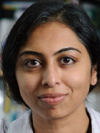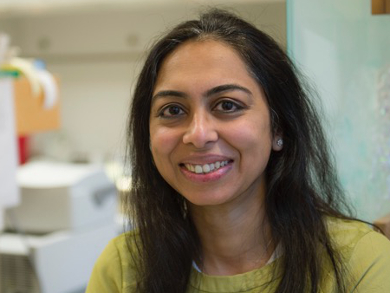Professor Yamuna Krishnan, University of Chicago, IL, USA, aims to develop a universal molecular imaging platform. She just moved her lab from Bangalore, India, to Chicago. Her latest research challenges, differences between India and the US, and good human relationships are topics she discussed with Dr. Vera Koester for ChemViews Magazine.
Could you briefly explain your research?
My lab seeks to use DNA like wool on the nanoscale. We knit it into shapes to create little nanobots that respond to the presence of specific chemicals by glowing in different colors. We graft molecular information onto these nanobots that allows them to sail into the nooks and crannies of living cells to report on how healthy or diseased the cell is.
This is exciting because we can now not only detect, but quantify protein activity inside cells while they are inside a living organism. This is important because we can identify small molecules that can have drug like activity with much greater ease inside whole organisms or whole cells without having to puree them into a soup.
What distinguishes our work from others in the field is that we harness DNA to map chemical environments of cells inside whole, living organisms.
Can you please give an example from your recent research?
We have recently made a pH independent chloride reporter that can now quantitate chloride in sub cellular organelles. This was a hard problem to crack as chloride sensors tend to also be pH sensitive, and defective chloride accumulation in an organelle also affects its lumenal pH!
What inspires your studies?
I want to explore the limits of DNA as a molecular scaffold in terms of synthetic function within a complex environment like a living cell. My drive stems from my desire to resolve a critical unmet need collectively faced by several sub-fields of biology. I want to do this by providing a functional-imaging solution that can change the nature of questions that can be asked.
So what do you want to create?
We want to create a molecular framework for small molecule imaging, which can serve as a universal molecular imaging platform. If successful, I see this being the life science researcher’s first go-to imaging solution, where they can get powerful clues as to which molecules, organelles, cells, or tissues they would want to probe, and how.
Which part of your work proved the most exciting, which the most challenging?
It’s impossible for me to pick. The whole journey so far has felt amazing, as we have watched each of our “wouldn’t-it-be-cool” ideas explode into reality. The more challenging they have been to achieve, the more exciting they finally turned out to be.
How important are interdisciplinary cooperations for your work?
As important as the air that I breathe. I have had – and this is remarkable – only enriching experiences in each collaboration I have embarked on. I have been very lucky that each of my collaborators is not just an outstanding scientist, but also a good human being. From them I have not only learnt about new areas in biology, but also the art of effective listening and the joy of communication and sharing.
You recently moved your lab from the National Center for Biological Sciences (NCBS), Bangalore, India, to the University of Chicago. How is it like continuing your research on another continent? What are main differences between India and the USA?
The pace of science in the US makes such a huge difference! You order a chemical today; it is on your table in three days. This allows you to follow an idea, fail fast and error-correct fast. In terms of facilities and instrumentation, I must say some of the best institutes in India are on par with the US. However, they are run far more effectively in the US. Lastly and probably most important, the scientific ecosystem in the US is far more diverse and has many high-quality groups in any single area. This allows a chemist like me to address the most appropriate biological problem with our chemical solutions, without worrying about whether there is the necessary biological expertise in the vicinity. Here, there is always someone fairly nearby.
What do you miss most about India? What do you like best in the US?
I miss my parents, who I left behind in order to follow a dream. I miss a few close friends, former colleagues, and staff members at my former institute.
I always remember my father’s words when I was weeping bitterly over a smashed toy: never cry over anything that cannot cry over you. It taught me that what is really precious is the right people. Again, this is also what I like best in the US – the people are its true wealth – my colleagues, collaborators, the students; their positivity, intellectual acuity, and their let’s-make-it-happen attitude.
We talked five years ago and one of your wishes for the future then was to continue to work with enthusiastic students. I hope this has come true.
What do you think is most important for them to learn?
Yes indeed! It is easy to work with students and postdocs who are already highly motivated and want to make a deep contribution, a difference to their chosen area. We are a close-knit group and whenever one of us is down, we are all there to help him or her to get back up.
The thing I hope each one learns: To see what you can do when you put your mind to it, take a leap of faith and give it all you’ve got.
Thank you very much for the interview.
 Yamuna Krishnan received her B.Sc. from Madras University in 1993 and her M.S. and Ph.D. from the Indian Institute of Science, Bangalore, in 1997 and 2002, respectively.
Yamuna Krishnan received her B.Sc. from Madras University in 1993 and her M.S. and Ph.D. from the Indian Institute of Science, Bangalore, in 1997 and 2002, respectively.
From 2001 to 2005, she was a postdoctoral research fellow at the University of Cambridge, UK, where she worked with Shankar Balasubramanian. She then moved back to India and joined the National Center for Biological Sciences (NCBS), Bengaluru, India, as Fellow. In 2009, she was promoted to Reader at the same institute, and became Associate Professor in 2013.
In 2014, Krishnan started her current position as Professor for Chemistry at the University of Chicago, IL, USA.
Selected Awards
- Brain Research Foundation’s Scientific Innovations Award, 2016
- Chemical Sciences Emerging Investigator Award, 2015
- Cell’s 40 under 40, 2014
- AVRA Young Scientist Award, 2014
- Shanti Swarup Bhatnagar Prize for Chemical Sciences, 2013 (youngest woman recipient)
- Indian National Science Academy’s Young Scientist Medal, 2009
Selected Publications
- Rational design of a quantitative, pH-insensitive, nucleic acid based fluorescent chloride reporter,
Ved Prakash, Sonali Saha, Kasturi Chakrabortya, Yamuna Krishnan,
Chem. Sci. 2016, 7, 1946–1953.
DOI: 10.1039/c5sc04002g - Designing DNA nanodevices for compatibility with the immune system of higher organisms,
Sunaina Surana, Avinash R. Shenoy, Yamuna Krishnan,
Nat. Nanotechnol. 2015, 10, 741–747.
DOI: 10.1038/nnano.2015.180 - A pH-independent DNA nanodevice for quantifying chloride transport in organelles of living cells,
Sonali Saha, Ved Prakash, Saheli Halder, Kasturi Chakraborty, Yamuna Krishna,
Nature Nanotechnol. 2015, 10, 645–651.
DOI: 10.1038/nnano.2015.130 - Controlled Release of Encapsulated Cargo from a DNA Icosahedron using a Chemical Trigger,
Anusuya Banerjee, Dhiraj Bhatia, Anand Saminathan, Saikat Chakraborty, Shaunak Kar, Yamuna Krishnan
Angew. Chem. Int. Ed. 2015.
DOI: 10.1002/anie.201302759 - Nucleic Acid Based Molecular Devices,
Yamuna Krishnan, Friedrich C. Simmel,
Angew. Chem. Int. Ed. 2011, 50, 3124–3156.
DOI: 10.1002/anie.200907223 - Icosahedral DNA Nanocapsules by Modular Assembly,
Dhiraj Bhatia, Shabana Mehtab, Ramya Krishnan, Shantinath S. Indi, Atanu Basu, Yamuna Krishnan,
Angew. Chem. Int. Ed. 2009, 48, 4134–4137.
DOI: 10.1002/anie.200806000 - A DNA nanomachine that maps spatial and temporal pH changes inside living cells,
Souvik Modi, Swetha M. G., Debanjan Goswami, Gagan D. Gupta, Satyajit Mayor, Yamuna Krishnan,
Nat. Nanotechnol. 2009, 4, 325–330.
DOI: 10.1038/nnano.2009.83
Also of Interest
- Women in Chemistry – Interview with Yamuna Krishnan,
Vera Koester,
ChemViews Mag. 2016.
DOI: 10.1002/chemv.201000073
Yamuna Krishnan, NCBS, India, already perfomed a remarkable career, is enthusiastic not only about sciences, inspired by Mahatma Gandhi - Women in Chemistry – Interview Series


